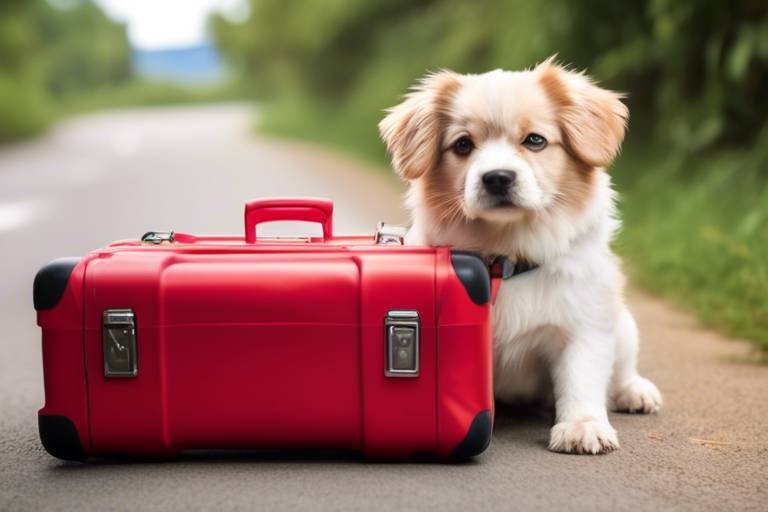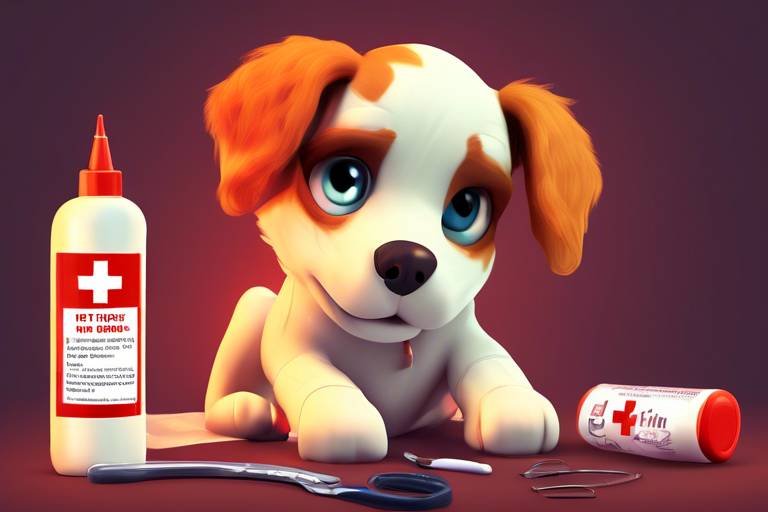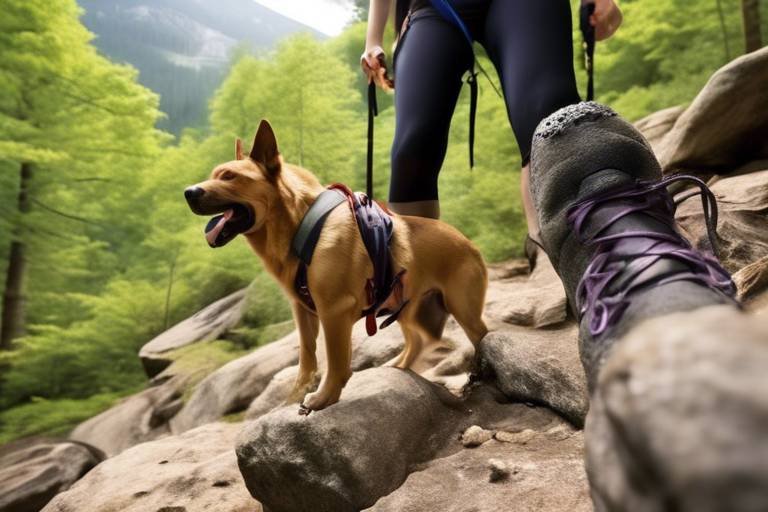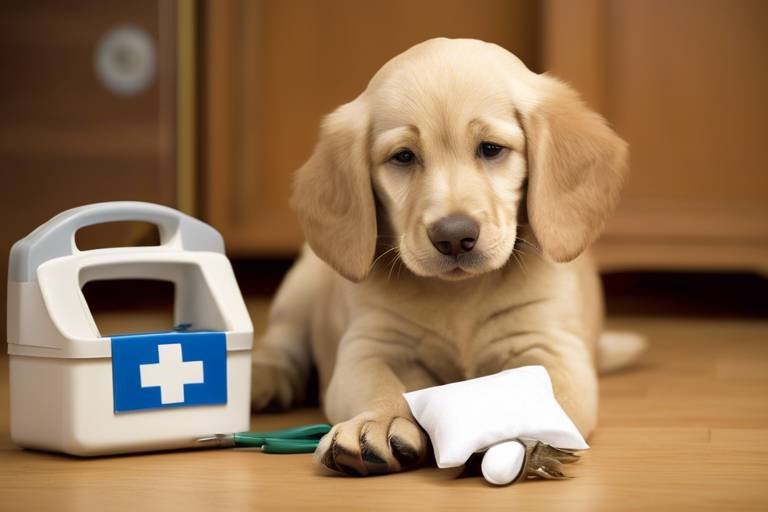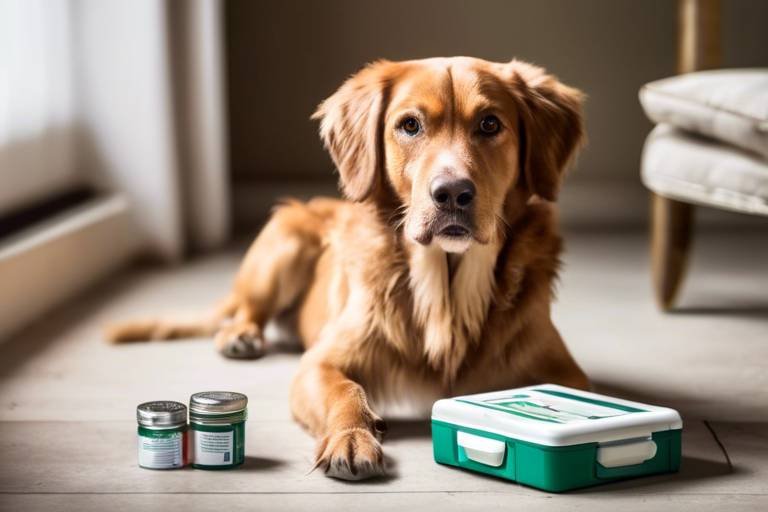How to Handle a Pet Emergency When Traveling
Traveling with your furry companions can be one of the most rewarding experiences, but it also comes with its own set of challenges, especially when it comes to handling emergencies. Imagine you're on a long-awaited road trip, the sun is shining, and your pet is happily wagging their tail in the backseat. Suddenly, a mishap occurs—your pet gets injured, or perhaps they start showing signs of distress. In moments like these, knowing how to handle a pet emergency is crucial. This article explores essential strategies for managing pet emergencies while on the go, ensuring your furry friends receive prompt care and support during unexpected situations.
Recognizing the types of emergencies that can occur while traveling with pets is crucial. Just like humans, our pets can face a variety of health issues on the road. Common emergencies include:
- Injuries: Cuts, scrapes, or fractures from accidents.
- Illnesses: Sudden onset of vomiting, diarrhea, or lethargy.
- Allergic Reactions: Swelling, itching, or difficulty breathing after exposure to allergens.
Being aware of these potential issues can help you stay calm and act quickly. Just think of it as being prepared for a rainstorm; if you have an umbrella handy, you're less likely to get soaked!
An emergency kit is vital for pet owners on the move. Think of it as your pet's safety net. Here’s what you should include:
| Item | Purpose |
|---|---|
| First Aid Supplies | To treat minor injuries and stabilize your pet until you can reach a vet. |
| Medications | Any prescribed medication your pet may need during your travels. |
| Emergency Contact List | Includes local veterinarians and emergency clinics. |
| Food and Water | Keep your pet nourished and hydrated, especially during long trips. |
Having these items at your fingertips can be a game-changer in a crisis.
First aid supplies can be lifesavers in emergencies. Your pet's first aid kit should include:
- Bandages and gauze
- Antiseptic wipes
- Scissors
- Thermometer
- Emergency contact information
Each of these items plays a vital role in providing immediate care. Just like a well-stocked toolbox, having the right supplies can help you tackle any situation that arises.
Having the right contact information is essential during a pet emergency. You should keep a list of local veterinarians and emergency clinics handy while traveling. This could be a physical list in your emergency kit or saved in your phone. Imagine trying to find help in a new city—having this information readily available can save precious time and reduce panic.
Understanding your pet's behavior is key to identifying distress. Pets can’t tell us what’s wrong, so we need to be their advocates. Look for signs such as:
- Unusual vocalizations (whining, yelping)
- Excessive panting or drooling
- Changes in appetite or drinking habits
- Behavioral changes (hiding, aggression)
Being attuned to these signs can help you act quickly and get your pet the help they need.
Locating veterinary services while traveling can be challenging. But fear not! There are effective strategies for finding nearby clinics or animal hospitals in case of an emergency. Think of it as a treasure hunt where your pet's health is the prize!
Mobile apps can simplify the process of finding veterinary care. Apps like Pet First Aid and VetFinder are designed for pet owners, making it easier to locate nearby services when you need them most. Just a few taps on your phone can lead you to the help your pet needs!
Local residents can be invaluable resources during a pet emergency. Don't hesitate to ask for recommendations from locals to find trusted veterinary services quickly. A friendly local can often point you to the best clinics, saving you time and worry.
Having a plan in place can significantly reduce stress during a pet emergency. Here are some steps to create an effective emergency plan tailored to your travel needs and your pet's requirements:
- Identify nearby veterinary clinics along your route.
- Keep your pet's medical records and vaccination information handy.
- Establish a communication plan with your travel companions.
By being proactive and prepared, you can ensure that both you and your pet have a smoother journey, even when unexpected events arise.
Q: What should I do if my pet gets injured while traveling?
A: Stay calm, assess the injury, and use your first aid kit if necessary. Contact a local veterinarian as soon as possible.
Q: How can I keep my pet calm during a travel emergency?
A: Speak to your pet in a soothing voice, pet them gently, and try to keep the environment as calm as possible.
Q: Is it necessary to have pet insurance while traveling?
A: While not mandatory, pet insurance can provide peace of mind and help cover unexpected veterinary costs during your travels.

Understanding Common Pet Emergencies
Traveling with your furry friend can be one of the most rewarding experiences, but it also comes with its own set of challenges, especially when it comes to pet emergencies. Just like humans, pets can face a variety of unexpected health issues while on the road. Understanding these common emergencies is crucial for every pet owner. After all, a little knowledge can go a long way in ensuring your pet's safety and well-being.
One of the most frequent emergencies pet owners encounter is injuries. Whether it's a cut from sharp objects on the ground or a sprain from jumping out of the car, injuries can happen in the blink of an eye. It's vital to be prepared to handle these situations promptly. For instance, if your dog steps on glass, your immediate reaction should be to clean the wound and apply a bandage. Remember, the quicker you act, the better the outcome for your pet.
Another common issue is illness. Pets can fall ill due to various reasons, such as changes in diet or exposure to new environments. Symptoms might include vomiting, diarrhea, or lethargy. If you notice any unusual behavior, it's essential to monitor your pet closely. Sometimes, a simple change in their food or a new treat can cause digestive upset. Always keep an eye on what they eat, especially during travel.
Allergic reactions are also something to watch out for. Just like us, pets can have allergies to certain foods, plants, or even insect bites. If your pet starts scratching excessively, develops hives, or shows signs of swelling, it could be an allergic reaction. In such cases, seeking immediate veterinary care is crucial, as some reactions can escalate quickly and become life-threatening.
To give you a clearer picture, here’s a quick table summarizing some common pet emergencies:
| Emergency Type | Symptoms | Immediate Action |
|---|---|---|
| Injury | Bleeding, limping, whining | Clean the wound, apply pressure, seek vet care |
| Illness | Vomiting, diarrhea, lethargy | Monitor closely, consult a vet if symptoms persist |
| Allergic Reaction | Scratching, swelling, hives | Administer antihistamines if advised, seek vet care |
By being aware of these common emergencies and their symptoms, you can act swiftly and effectively. Remember, your pet relies on you to recognize when something isn’t right. Always trust your instincts—if you think something is off, don’t hesitate to seek help. Your furry companion deserves nothing less than the best care, and being prepared is the first step in ensuring their safety during your travels.

Preparing an Emergency Kit
When you embark on a journey with your furry companion, the last thing you want is to find yourself unprepared for an emergency. An emergency kit is not just a nice-to-have; it's a necessity. Think of it as your pet's safety net while you're on the road. Just like you wouldn’t set off on a road trip without your own essentials, your pet deserves the same level of preparation. So, what should you include in this all-important kit?
First and foremost, consider the first aid supplies. These items can be lifesavers in critical situations. You’ll want to pack a variety of bandages, antiseptics, and gauze to handle minor injuries. Additionally, including a pet thermometer can help you monitor your pet's health on the go. Here’s a quick overview of essential first aid supplies:
| Item | Purpose |
|---|---|
| Adhesive Bandages | To cover small cuts and abrasions |
| Antiseptic Wipes | To clean wounds and prevent infection |
| Gauze Pads | To absorb blood and protect larger wounds |
| Pet Thermometer | To check for fever |
| Scissors | For cutting bandages or gauze |
Next, don’t forget to include your pet’s medications in the emergency kit. Just like humans, pets may require specific medications for ongoing health issues. Keeping a supply of these medications, along with a copy of your pet's medical records, can save precious time in an emergency. Imagine rushing to a vet only to realize you forgot your pet's medication at home; that could be a nightmare!
Another essential component of your emergency kit is contact information. Make sure to have a list of local veterinarians and emergency clinics in the areas you’ll be traveling to. This way, you can quickly reach out for help if needed. You can easily create a small card with this information or store it in your phone for easy access. In a stressful situation, having this information at your fingertips can make a world of difference.
Lastly, consider including comfort items for your pet. Familiar toys or a favorite blanket can help soothe your pet in unfamiliar surroundings. Just like us, pets can feel anxious when they are away from home. A little piece of home can go a long way in calming their nerves. You might also want to bring along some extra food and water, as well as collapsible bowls for feeding on the go.
In summary, preparing an emergency kit for your pet is all about being proactive. It’s about ensuring that you have the right tools and resources to handle any situation that might arise while you’re traveling. By taking the time to gather these items before your trip, you can travel with peace of mind, knowing that you're ready for anything life throws your way.
First Aid Supplies
When you're on the road with your furry companion, the last thing you want is to be caught unprepared in case of an emergency. That's why having a well-stocked pet first aid kit is not just a good idea—it's essential! Think of it as your pet's safety net, ready to catch them in case they take a tumble or encounter an unexpected health issue. So, what should you include in this lifesaving kit? Let's break it down.
First off, you’ll want to include bandages of various sizes. These are crucial for wrapping up cuts or scrapes. Just like we need a little TLC when we get hurt, your pet will appreciate the same! Alongside bandages, antiseptics are a must. They help to clean wounds and prevent infections, which is something you definitely want to avoid on your travels.
But that’s not all! Consider adding gauze pads and medical tape to your kit. These items can be used to secure bandages and control bleeding, ensuring that your pet stays safe until you can get them to a vet. And let’s not forget about scissors—a handy tool for cutting tape or gauze, or even trimming fur away from a wound.
Another important item is a digital thermometer. Pets can’t tell us when they’re feeling under the weather, but a quick temperature check can give you a clue. If your pet's temperature is above the normal range (generally between 100.5°F and 102.5°F), it might be time to seek veterinary care.
To make things even easier, here’s a quick overview of essential first aid supplies you should have in your kit:
| Item | Purpose |
|---|---|
| Bandages | To cover cuts and scrapes |
| Antiseptics | To clean wounds and prevent infection |
| Gauze Pads | For wound dressing and bleeding control |
| Medical Tape | To secure bandages in place |
| Scissors | To cut tape, gauze, or fur |
| Digital Thermometer | To check for fever |
Lastly, don't forget to include a copy of your pet's medical records, especially if they have any ongoing health issues. This will give veterinarians the information they need to provide the best care possible in an emergency. Having these supplies on hand can make a world of difference when your pet needs immediate attention. Remember, a little preparation goes a long way in ensuring your pet's safety and well-being while you’re out exploring the world together!
Contact Information
When it comes to handling a pet emergency while traveling, having the right at your fingertips can make all the difference. Imagine being in a new city, your furry friend suddenly showing signs of distress, and you have no idea where to turn. Panic can set in quickly, but with a well-prepared list of contacts, you can navigate through the chaos more smoothly. Start by compiling a list of local veterinarians and emergency clinics in the areas you plan to visit. This way, you won't be frantically searching for help when time is of the essence.
Here are some essential contacts to include in your emergency kit:
- Local Veterinarians: Research veterinarians in the area before you arrive. Websites and apps can help you find reputable clinics.
- Emergency Animal Hospitals: Not all veterinary clinics offer emergency services, so it's crucial to identify those that do.
- Pet Poison Control Hotline: Accidents happen, and knowing who to call in case of poisoning can save your pet's life.
Additionally, it's wise to keep the contact information of your regular veterinarian at home. They can provide valuable advice over the phone and may even recommend trusted vets in your travel vicinity. For convenience, consider storing this information in your phone or a dedicated app, ensuring it’s accessible even if you’re in a rush.
Lastly, don’t forget to jot down the addresses and phone numbers of nearby animal shelters or rescue organizations. In some cases, they can offer temporary assistance or guidance in finding veterinary care. By having this comprehensive contact list readily available, you'll be better equipped to handle any unexpected situations that arise while traveling with your beloved pet.
Q: What should I do if my pet gets injured while traveling?
A: Stay calm and assess the situation. If it's a minor injury, clean it and apply a bandage from your emergency kit. For serious injuries, contact a local veterinarian immediately.
Q: How can I find a vet in an unfamiliar area?
A: Use mobile apps designed for pet owners, search online, or ask locals for recommendations to find nearby veterinary services.
Q: What should I include in my pet's emergency kit?
A: Essential items include first aid supplies, food and water, medications, contact information for vets, and a copy of your pet's medical records.
Q: How can I tell if my pet is in distress?
A: Look for signs such as excessive barking, whining, panting, or unusual behavior. If you notice any of these, it’s best to consult a vet.

Recognizing Signs of Distress
When traveling with your furry companion, it's essential to keep a close eye on their behavior. Just like humans, pets can experience distress, and recognizing the signs early can make all the difference in their well-being. So, what should you be looking for? First off, changes in behavior are often the most noticeable indicators. If your normally playful pup suddenly becomes lethargic or your curious cat hides away, it might be time to investigate further.
Physical symptoms can also be telling. For instance, excessive panting, drooling, or shaking can indicate that your pet is feeling anxious or uncomfortable. You might also notice them pacing or attempting to escape their carrier—these behaviors can signal distress. Additionally, keep an eye out for changes in eating and drinking habits; if your pet refuses to eat or drink while on the road, it could be a sign of nausea or anxiety.
Another important aspect to consider is your pet's vocalization. Increased barking, whining, or meowing can indicate discomfort or fear. It's essential to pay attention to these vocal cues, as they can provide insight into how your pet is feeling. For example, if your dog is barking excessively, it might be reacting to unfamiliar surroundings or sounds. Similarly, if your cat is vocalizing more than usual, they could be feeling stressed due to travel.
Moreover, understanding the body language of your pet can be incredibly helpful. Signs of distress may include:
- Tail between the legs in dogs
- Flattened ears in cats
- Excessive grooming or licking
- Hiding or seeking isolation
Recognizing these signs is crucial, as they can help you intervene before a minor issue escalates into a significant problem. If you notice any of these behaviors, take a moment to assess the situation. Is your pet too hot? Are they uncomfortable in their carrier? Sometimes, simple adjustments can alleviate their distress.
In conclusion, staying attuned to your pet's emotional and physical state while traveling is vital for their health and happiness. By being proactive and observant, you can ensure that your furry friend remains comfortable and secure during your adventures together. Remember, a little attention can go a long way in preventing potential emergencies!
Q: What should I do if I notice signs of distress in my pet?
A: If you observe any signs of distress, assess the situation and try to identify the cause. Make adjustments to their environment, such as providing shade or a cooler area, and offer water. If symptoms persist, consult a veterinarian as soon as possible.
Q: How can I help my pet feel more comfortable while traveling?
A: Ensure they have a familiar blanket or toy, provide regular breaks during travel, and maintain a consistent feeding schedule. Additionally, consider using calming products like pheromone sprays or anxiety wraps.
Q: Are there specific breeds more prone to travel anxiety?
A: Yes, certain breeds, especially those known for being sensitive or high-strung, may experience more travel anxiety. It's essential to prepare and plan accordingly if you own such a breed.

Finding Veterinary Care on the Road
When you're on the road with your beloved pet, the last thing you want is to face a medical emergency. However, being prepared to find veterinary care can make all the difference in ensuring your furry friend gets the help they need. Whether you're embarking on a cross-country road trip or a quick getaway, knowing how to locate veterinary services can save precious time. So, how do you go about finding a vet when you’re miles away from home?
First and foremost, having a reliable way to search for veterinary clinics is crucial. One of the most effective methods is leveraging technology. Mobile apps designed specifically for pet owners can be a game changer. These apps often provide a comprehensive list of nearby veterinary services, complete with user reviews, ratings, and contact information. Imagine being able to pull out your phone, tap a few buttons, and instantly have a list of trusted vets at your fingertips! Popular apps like Pet First Aid and VetFinder can help you find clinics based on your location, making it easier than ever to get your pet the care they need.
But what if you’re in a remote area where internet access is spotty? In such cases, it’s a good idea to ask locals for recommendations. Local residents, especially those who are pet owners themselves, can often point you to the nearest veterinary clinic or animal hospital. They might even share their personal experiences, giving you insights into which vets are compassionate and effective. Just imagine striking up a conversation with a friendly local and discovering a hidden gem of a veterinary clinic that you wouldn't have found otherwise!
Another effective strategy is to keep a list of veterinary clinics saved in your phone or written down in your travel documents. Before you hit the road, do a little research on the areas you'll be traveling through. Create a simple table with the names, addresses, and phone numbers of veterinary clinics along your route. This way, if an emergency arises, you can quickly consult your list and head straight to the nearest clinic without wasting time searching online.
| Location | Veterinary Clinic Name | Contact Number |
|---|---|---|
| City A | Happy Paws Vet Clinic | (123) 456-7890 |
| City B | Care4Pets Animal Hospital | (234) 567-8901 |
| City C | Compassionate Vets | (345) 678-9012 |
Lastly, don’t forget to check if your pet insurance covers emergency visits at out-of-network clinics. This can save you a lot of stress and financial strain during an already tense situation. If you're unsure, give your insurance provider a quick call before you leave, so you have all the information you need at your disposal.
In summary, finding veterinary care on the road doesn’t have to be a daunting task. By using mobile apps, asking locals, and preparing a list of clinics in advance, you can ensure that your pet is in good hands no matter where your travels take you. Remember, a little preparation goes a long way in keeping your furry friend safe!
- What should I do if my pet has a medical emergency while traveling?
Stay calm, assess the situation, and use your resources to find the nearest veterinary clinic. If you have an emergency kit, use it to provide immediate care. - How can I find a vet quickly in an unfamiliar area?
Use mobile apps designed for pet owners, ask locals for recommendations, and consult your pre-prepared list of veterinary clinics. - Is it necessary to have pet insurance while traveling?
While it’s not mandatory, having pet insurance can ease the financial burden of unexpected veterinary visits, especially in emergencies.
Using Mobile Apps
In our tech-savvy world, mobile apps have become indispensable tools for pet owners, especially when it comes to managing emergencies on the go. Imagine you’re traveling with your furry companion and suddenly, they seem unwell or injured. Panic can set in quickly, but with the right apps at your fingertips, you can turn that anxiety into action. These apps not only help you locate nearby veterinary services but also provide valuable information on how to care for your pet in those critical moments.
One of the best features of these mobile apps is their ability to pinpoint veterinary clinics and emergency animal hospitals based on your current location. For example, apps like VetFinder and Pet First Aid can help you find the nearest veterinary services with just a few taps on your screen. They often come with user reviews, allowing you to gauge the quality of care provided by different facilities. This can be a lifesaver when you’re in an unfamiliar area and need to make a quick decision about where to take your pet.
Moreover, many of these apps are designed with user-friendly interfaces that make navigation a breeze, even in stressful situations. You can search for services by entering your location, or simply allow the app to access your GPS for instant results. Some apps even provide directions to the clinic, ensuring you don’t waste precious time trying to find your way. It’s like having a personal assistant dedicated to your pet’s health and safety!
Another fantastic feature of these mobile applications is their access to a wealth of information regarding pet health. They can offer tips on first aid procedures, advice on what to do in various emergency scenarios, and even reminders for vaccinations or medications. This information can empower you to act quickly and effectively, potentially saving your pet’s life. Imagine being able to read about symptoms or first aid techniques while you’re on the road, right when you need it most!
To give you a clearer picture, here’s a quick comparison of some popular mobile apps for pet owners:
| App Name | Features | Platforms |
|---|---|---|
| VetFinder | Find nearby vets, user reviews, emergency contacts | iOS, Android |
| Pet First Aid | First aid tips, vet locator, symptom checker | iOS, Android |
| Pawtrack | GPS tracking for pets, activity monitoring | iOS, Android |
| PetCoach | Ask vets questions, access health articles | iOS, Android |
In conclusion, utilizing mobile apps can significantly enhance your preparedness for pet emergencies while traveling. They not only provide essential information and resources but also offer peace of mind knowing that help is just a tap away. So, before you embark on your next adventure with your pet, take a moment to download a few of these helpful apps. Trust me, your furry friend will thank you for it!
Asking Locals for Help
When you're on the road with your furry companion, unexpected situations can arise, and knowing how to navigate them can make all the difference. One of the most effective strategies during a pet emergency is to ask locals for help. Think about it: who knows the area better than the people who live there? They can provide you with invaluable insights and recommendations that might not be readily available online.
Imagine you're in a small town, and your pet suddenly falls ill. You could spend precious time searching the internet for a nearby veterinary clinic, or you could simply ask a local. A friendly shop owner or a passerby might point you to a trusted vet who can provide immediate care. Plus, locals often have firsthand experiences with the services they recommend, which can give you peace of mind.
Here are some tips on how to effectively ask locals for help:
- Be Friendly: A warm smile and a polite approach can go a long way. People are more likely to help if you come across as approachable.
- Explain Your Situation: Clearly state that you’re traveling and that your pet is in need of assistance. This context can prompt locals to take your request more seriously.
- Ask Specific Questions: Instead of just asking for a vet, inquire about the best vet in the area or if they know of any emergency clinics nearby. Specific questions can yield more useful answers.
In addition to asking individuals, consider visiting local businesses such as pet stores or even cafes. These places often have bulletin boards with flyers or business cards from local vets and pet services. You might also find locals who are pet owners themselves and can share their experiences and recommendations.
Furthermore, don’t hesitate to use social media platforms or community apps to reach out for help. Posting in local Facebook groups or using apps like Nextdoor can connect you with pet owners in the area who may have useful information or suggestions. Remember, the more you engage with the community, the more support you’re likely to receive.
In summary, when you're in a pinch with your pet while traveling, reaching out to locals can be a game-changer. They can guide you to reliable veterinary services and provide you with the support you need to ensure your furry friend receives the best care possible.

Traveling with a Pet Emergency Plan
Having a well-thought-out emergency plan for your pet while traveling can be the difference between a minor hiccup and a major crisis. Imagine this: you’re on a road trip, the sun is shining, and your furry friend is happily wagging their tail in the backseat. Suddenly, they start to whimper or show signs of distress. Panic sets in, right? But if you’ve prepared in advance, you can navigate the situation with confidence and clarity.
First and foremost, your emergency plan should be tailored to fit both your travel style and your pet’s unique needs. Start by considering the specific risks associated with your destination and mode of travel. For instance, if you’re heading to a remote area, ensure you have access to veterinary services nearby. If you're flying, check the airline's pet policies and what to do in case of an emergency at 30,000 feet. By anticipating potential issues, you can reduce stress and ensure your pet's safety.
Next, it’s crucial to create a checklist of essential items to pack for your pet. This can include everything from their favorite toys to a copy of their medical records. Don’t forget to include important medications, food, water, and any necessary travel gear. Having these items on hand will not only keep your pet comfortable but will also make it easier to manage any emergencies that arise. A well-stocked emergency kit can be a lifesaver, so make sure to check it before you hit the road.
In addition to physical preparations, it’s also wise to discuss your emergency plan with anyone traveling with you. Make sure everyone knows what to do in case of an emergency, including how to recognize signs of distress in your pet. Consider having a designated “pet caretaker” who will be responsible for monitoring your pet's behavior and health. This way, you can focus on driving or navigating without worrying about missing any critical signs that your furry friend might need help.
Lastly, don’t underestimate the power of communication. If you’re traveling with a partner or family, keep lines of communication open. Regularly check in with each other about how your pet is doing. If you’re traveling solo, consider sharing your itinerary with a friend or family member. This way, someone will know where you are and can help if you encounter a problem. Keeping your loved ones in the loop can provide peace of mind and additional support during your travels.
In conclusion, traveling with a pet can be a joyful experience, but being prepared for emergencies is essential. By creating a comprehensive emergency plan, packing thoughtfully, and communicating effectively, you can ensure that both you and your pet have a safe and enjoyable journey. Remember, a little preparation goes a long way in turning potential crises into manageable situations!
- What should I include in a pet emergency kit? Your kit should include first aid supplies, medications, food, water, a leash, and copies of your pet's medical records.
- How can I find a vet while traveling? Use mobile apps or ask locals for recommendations. It's always good to have a list of nearby veterinary clinics before you travel.
- What signs should I look for to know if my pet is in distress? Look for excessive barking, whining, lethargy, or unusual behavior. If you notice any of these signs, it’s best to seek help immediately.
Frequently Asked Questions
- What should I include in my pet emergency kit?
Your pet emergency kit should contain essential items such as first aid supplies (bandages, antiseptics), any medications your pet may need, a copy of your pet's medical records, food and water, a leash, and a comfort item like a favorite toy. Having these items ready can make a huge difference in a critical situation.
- How can I recognize if my pet is in distress?
Pets can’t speak, but they communicate through their behavior. Look for signs like excessive panting, whining, hiding, or changes in appetite. If your pet is acting unusually, it might be time to seek veterinary advice.
- What are some effective ways to find veterinary care while traveling?
Using mobile apps designed for pet owners is a great way to locate nearby veterinary services. Additionally, don’t hesitate to ask locals for recommendations; they often know the best and most trusted clinics in the area.
- Why is it important to have a pet emergency plan?
Having a pet emergency plan can help reduce stress and confusion during a crisis. It ensures that you know what steps to take, where to go for help, and what supplies you need, allowing you to act quickly and efficiently when your pet needs it most.
- What should I do if my pet has an allergic reaction while traveling?
If you suspect your pet is having an allergic reaction, look for symptoms like swelling, itching, or difficulty breathing. Keep antihistamines on hand if your vet has approved them, and seek immediate veterinary care if symptoms are severe. Time is crucial in these situations!

